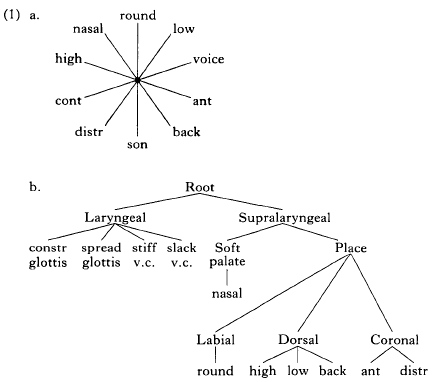Crossref Citations
This article has been cited by the following publications. This list is generated based on data provided by
Crossref.
Gussmann, Edmund
1992.
On government in phonology.
Journal of Linguistics,
Vol. 28,
Issue. 2,
p.
485.
Sproat, Richard
and
Fujimura, Osamu
1993.
Allophonic variation in English /l/ and its implications for phonetic implementation.
Journal of Phonetics,
Vol. 21,
Issue. 3,
p.
291.
Stemberger, Joseph Paul
1993.
Glottal transparency.
Phonology,
Vol. 10,
Issue. 1,
p.
107.
Chiosáin, Máire Ni
1994.
Irish palatalisation and the representation of place features.
Phonology,
Vol. 11,
Issue. 1,
p.
89.
Casali, Roderic F.
1995.
Labial opacity and roundness harmony in Nawuri.
Natural Language and Linguistic Theory,
Vol. 13,
Issue. 4,
p.
649.
Leo Wetzels, W.
1995.
Mid-vowel alternations in the Brazilian Portuguese verb.
Phonology,
Vol. 12,
Issue. 2,
p.
281.
Chen, Matthew
1996.
New Horizons in Chinese Linguistics.
Vol. 36,
Issue. ,
p.
21.
McDonough, Joyce
and
Johnson, Keith
1997.
Tamil liquids: An investigation into the basis of the contrast among five liquids in a dialect of Tamil.
Journal of the International Phonetic Association,
Vol. 27,
Issue. 1-2,
p.
1.
Coleman, John
1998.
Cognitive reality and the phonological lexicon: A review.
Journal of Neurolinguistics,
Vol. 11,
Issue. 3,
p.
295.
2000.
Phonological Projection.
p.
365.
Halle, Morris
Vaux, Bert
and
Wolfe, Andrew
2000.
On Feature Spreading and the Representation of Place of Articulation.
Linguistic Inquiry,
Vol. 31,
Issue. 3,
p.
387.
Staun, Jørgen
2003.
On vocalic feature hierarchisation.
Language Sciences,
Vol. 25,
Issue. 2,
p.
111.
Casali, Roderic F.
2003.
[ATR] value asymmetries and underlying vowel inventory structure in Niger-Congo and Nilo-Saharan.
Linguistic Typology,
Vol. 7,
Issue. 3,
Padgett, Jaye
2004.
Optimality Theory in Phonology.
p.
379.
Beckman, Jill
2004.
Optimality Theory in Phonology.
p.
310.
Hall, T. A.
2008.
Middle High German [rs] > [r ] as height dissimilation.
The Journal of Comparative Germanic Linguistics,
Vol. 11,
Issue. 3,
p.
213.
McCarthy, John J.
2008.
The gradual path to cluster simplification.
Phonology,
Vol. 25,
Issue. 2,
p.
271.
2011.
The Handbook of Phonological Theory.
p.
779.
Pulleyblank, Douglas
2011.
The Blackwell Companion to Phonology.
p.
1.
Morén‐Duolljá, Bruce
2011.
The Blackwell Companion to Phonology.
p.
1.





